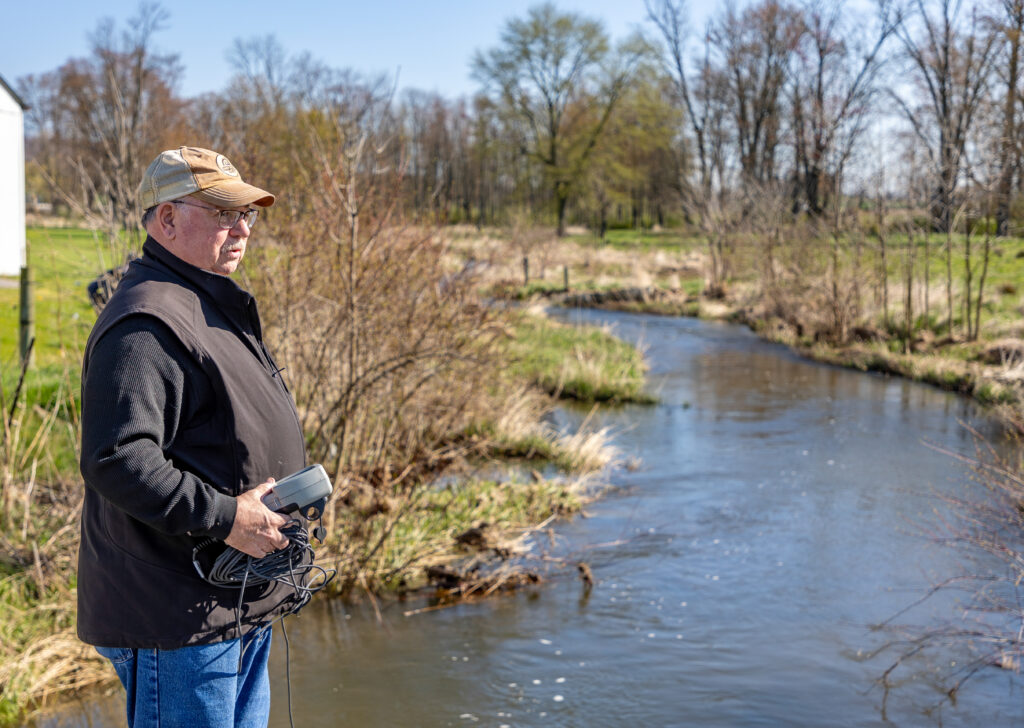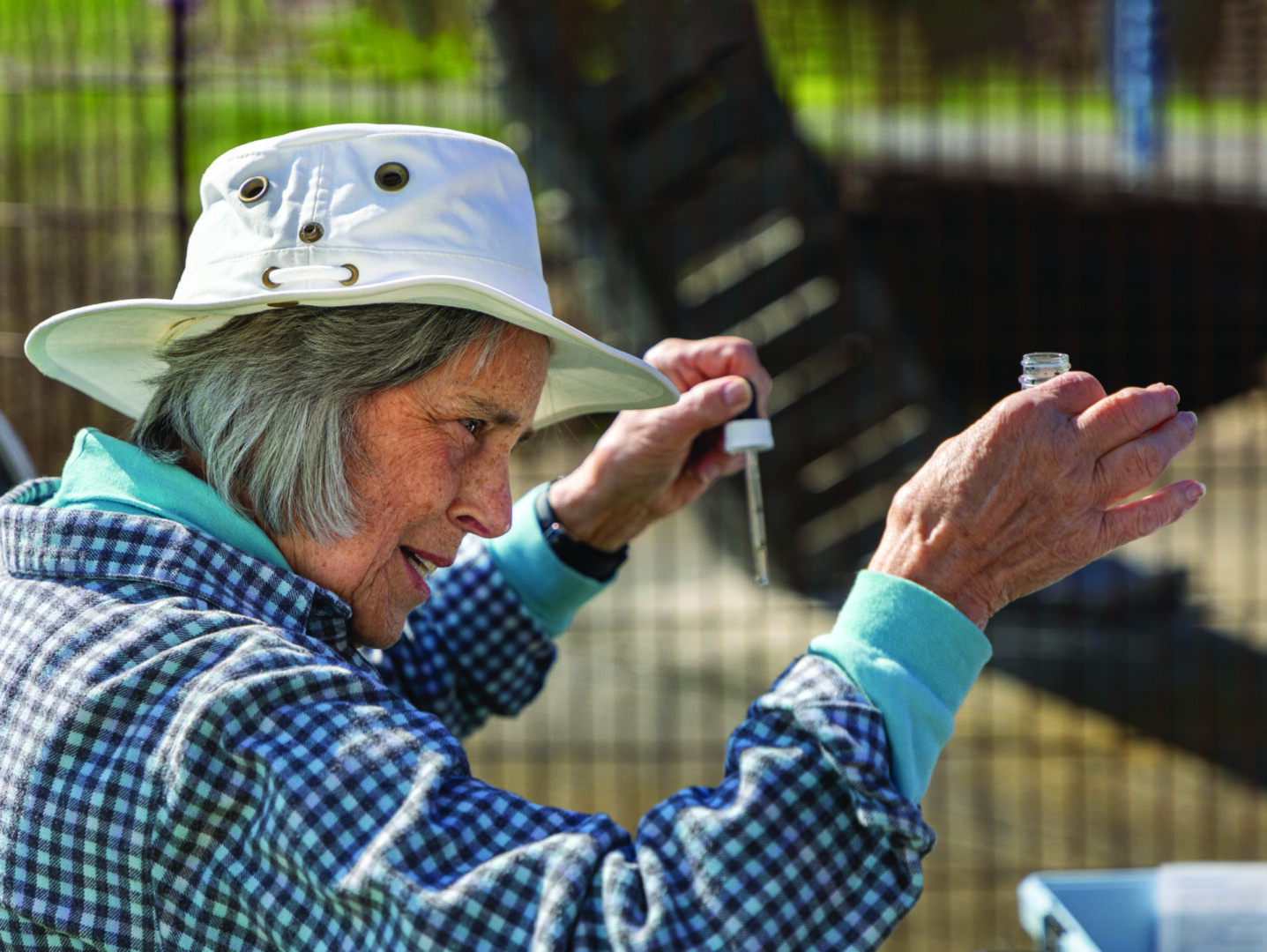This story originally appeared in the June 2024 edition of Town&Gown Magazine.
On a crisp, sunny morning in April, a small group of retirees congregated along the banks of Little Fishing Creek in Walker Township.
Although these five individuals were clearly familiar with each other, as evidenced by plenty of friendly banter and laughter, they weren’t gathered there to fish or to hike or even to simply enjoy the scenery together. They were there to provide a valuable service as members of the Centre County Pennsylvania Senior Environmental Corps.
According to CCPaSEC President Bill Smith, the organization is made up of about 40 volunteers who are responsible for closely monitoring the health of the streams in the Centre County watershed. The volunteers are divided into 14 teams, which are each assigned specific sites across the county to analyze each month.
A team at work
To determine water quality in a stream, the volunteers measure the temperature and chemical makeup of the water. They also calculate the stream’s depth, width and flow velocity, and count the various species of macro-invertebrates there.
Smith’s team is always assigned to two spots along Little Fishing Creek—one on Tice Farm along Hublersburg Road and one a few miles away, near the intersection of Snydertown Road and Route 64.
On this particular day, in the aftermath of the heavy rains that plagued Centre County in early April, the stream at the Tice Farm site is high and flowing fast. Outfitted in boots and fishing waders, team member Dave Kantner wades into the water’s edge to scoop out a bucket of water, from which team leader Genevieve Robine fills test tubes on the open tailgate of a pickup truck. Robine then tests each individual sample for the presence of nitrates, sulfates, phosphates and alkalinity, using a small piece of equipment known as a colorimeter.
“The colorimeter is the most technical instrument that we use,” Smith explains. “You have to follow procedures very closely and do that very carefully to get the right numbers.”
While Robine is preparing and testing her samples, Smith stands on a bridge with another handheld device, from which a thin black hose attached to a probe dangles into the stream in order to measure the dissolved oxygen levels in the water.
Meanwhile, Kantner ventures into the stream to cross it as Scott Williams stands along the bank. The two stretch a measuring tape across the water to assess the width. Kantner, standing in water that sometimes goes up to his thigh, then uses another device to take depth measurements at 10 different spots across the creek. Later, the team will plug the findings into a computer program that will calculate the velocity of the flow of the stream.
The team is joined by Dave DeCapria, who is not a member of this team; he is a quality control volunteer for the organization. He conducts the same tests alongside them, eventually comparing his findings to theirs, to ensure the accuracy of the data.
This monitoring is performed each month throughout the year, unless the weather creates dangerous conditions for the volunteers—for example, if the stream or its banks are icy.

Larvae and crayfish and leeches, oh my
In addition to the chemical analysis, the team performs a biodiversity survey twice a year, in which they count a sample of macro-invertebrate species found in the stream at their site.
They are due to perform the survey this time, but the team determines that the water is too high to safely collect a sample at the Tice Farm site. At the second site along Snydertown Road, however, Kantner wades in to assess the situation, and decides yes, it’s shallow enough to give the macro test a whirl.
This time, Kantner and Robine wade into the stream. Robine rakes up the bottom of the stream while Kantner submerges a tightly meshed net underwater a few feet away, where it can capture a sampling of anything that the raking has dislodged.
When he pulls out the net, he carefully carries it over to a tall card table and spreads it open on top of a white vinyl tablecloth. At first glance, it looks like he’s managed to catch nothing but mud, leaves, sticks and a crayfish, but look closer and you soon see tiny little creatures start wriggling around in the muck.
The team members use tweezers to pluck out what look like tiny black bugs or even tinier squirmy worms, calling out what they find—creatures like water pennies, riffle beetle, caddis fly larvae and mayfly nymphs.
They’re placed into hard plastic egg cartons or a divided Rubbermaid container filled with water. Then, they are counted and recorded on a form, where they are sorted into categories of “sensitive” (most of the larvae), “somewhat sensitive” (crayfish, clams, dragonfly nymphs) and “tolerant” (snails, leeches, worms). The numbers are plugged into simple multiplying equations based on their category and then added together. Generally, the more species that fall into the “sensitive” category, the healthier the stream is determined to be.
This day’s macro-invertebrate survey results in a “fair” rating, but Robine suspects this is mainly because the depth of the stream made it difficult to collect a decent sample.
How the data is used
CCPaSEC teams conduct similar tests all across the county, in streams like Bald Eagle Creek, Beech Creek, Elk Creek, Slab Cabin Run, Sinking Creek and more. Two of the fourteen teams are assigned to Marcellus Shale sites in the northwestern part of the county, looking for any signs of contaminants from drilling sites.
Findings are published on the CCPaSEC website, and records date back to 2003, the year the organization was founded.
“I enter all the data in our database, and anybody can use our database. And we know for sure that the DEP [Department of Environmental Protection] does look at it,” Robine explains.
In addition, Smith says, any anomalies or concerning results are reported to Centre County officials. However, he explains, interest in the health of local streams extends beyond county lines, because, “We are part of the Chesapeake Bay watershed. All of the water here flows into the Chesapeake Bay.”
No experience necessary
Smith, a retired meteorologist, says the volunteers who join CCPaSEC come from all walks of life. Robine is a retired biology teacher, Williams is a retired chemistry teacher and Kantner is a retired police officer.
Generally, volunteers come to the organization through either RSVP (Retired and Senior Volunteer Program) of Centre County or ClearWater Conservancy.
Kantner says, “I first learned about [CCPaSEC] when I went to a volunteer fair. I’m retired, and I found it interesting. I love nature; we’re always out hiking and camping. So this is right up my alley.”
Although technical equipment and scientific methods are used, no experience is required. The organization trains new volunteers.
Smith, who joined the organization in 2016, says, “I was trained in the field. I was sort of walked through everything, like how to calibrate and use the dissolved oxygen meter, how to use the colorimeter, how to do the actual testing, how to test for alkalinity. … We prefer to train a little beforehand, but sometimes you learn more by doing.”
The organization purchases its equipment, which can be expensive, with help from ClearWater Conservancy and the Centre County Conservation District, as well as through grants from the Western Pennsylvania Conservancy.
The entire CCPaSEC organization comes together occasionally for special events like holiday parties or a summer picnic at Bald Eagle State Park. Still, it’s the monthly hands-on testing events that keep volunteers coming back, says Kantner.
“I love doing this. It’s fascinating, and it’s a lot of fun.” T&G
Karen Walker is a freelance writer in State College.
For more information, visit ccpasec.org. To become a CCPaSEC volunteer, contact RSVP at (814) 355-6816 / breeve@centrecountypa.gov, or ClearWater Conservancy at (814) 237-0400/clearwater@clearwaterconservancy.org.



